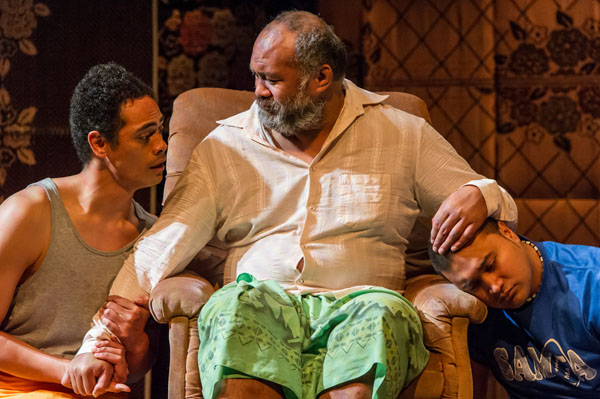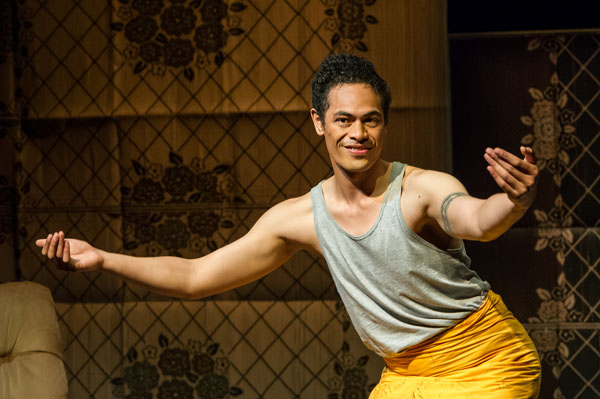A Frigate Bird Sings
By David Fane and Oscar Kightley
Directed by Alison Quigan
Auckland Theatre Company
Mangere Arts Centre, Auckland October 11-20 2012
Review by Sam Brooks October 16, 2012
Image Credit: Michael Smith

NOT TOO LONG into A Frigate Bird Sings, we’re told about the titular frigate bird, a bird that serves as an omen in Samoa: when you see a frigate bird, you know a storm is coming. Throughout the play, the frigate bird serves as a beautiful metaphor for the fa’afafine, a third gender in Samoan society, and a much unexplored and underrepresented subject on stage.A Frigate Bird Sings brilliantly tackles the many cultural and personal complexities of the fa’afafine with a bracing honesty and gentle comic touch.
Vili (Taofia Pelesasa) is a fa’afafine. After the death of her mother, Vili takes care of her father Kapili (David Fane) and her younger brother Sione (Troy Tu’ua). Both her dedication to and struggles with her family form the backbone of the play, especially as Vili starts to go out and meets other fa’afafine in Dejavu (Shimpal Lelisi) and Shaniqua (Amanaki Prescott). Vili is torn between her responsibilities to look after her family and her desire to have a life of her own, and throughout the play we see how these things can’t both happen.
The script, written by David Fane, Oscar Kightley and Nathaniel Lees is an utter triumph. It tackles a subject that I haven’t seen broached on stage before—not only of the fa’afafine’s role in Samoan culture, but their role in the family, and how they fit into New Zealand culture. Prior to the play, I was familiar with fa’afafine and their role in society, but the play does a brilliant job of humanizing what is, to many of us, just part of somebody else’s culture, somebody else’s life. It doesn’t glamourize or tokenize the fa’afafine into people that should be pitied, but people with their own struggles, joys, light, and darkness. It’s the central triumph of a script that has many others.
For one, the script doesn’t hold anything back. There’s an honest, raw depiction of a Samoan family shaken to the core by the death of the matriarch, one that is felt throughout the rest of the play. Kapili is particularly shaken by his wife’s death and descends into drinking and gambling, while Vili fills the role of mother, daughter, and son, fending off his physical and verbal abuse while keeping the house together. It also doesn’t hold any of the humour back. There’s a bawdy sense of humour that keeps things from becoming too heavy, and it’s as much a coping mechanism for the characters as it is a fundamental part of their lives: they laugh because they have to. It’s a credit to the writers that the play remains engaging while switching between tones almost on a dime. Thus, it becomes a compelling, layered, and complex exploration of both the fa’afafine and the Samoan family unit.
As the lead in the play, Taofia Pelesasa has a difficult job. He has to play Vili as both somebody performing many roles, but also as her own person within those roles. Throughout the play Vili really discovers herself and exactly where she fits not only within her own culture, but within the Western culture which she’s been placed. Pelesasa plays that journey beautifully, losing himself physically and vocally in the role, and hitting every comic beat as well as he plays every dramatic beat. It’s a great role for a great actor, and he effortlessly holds the stage and space throughout.

The cast surrounding Pelesasa is no less remarkable. Fane’s Kapili is a man who teeters on the edge of falling right into the drink, and he plays the man’s oscillating levels of self-knowledge with precision. As Sione, Troy Tu’ua is often the comic relief, but when his character gets into the darker territory, his quietness becomes truly affecting. Peter Coates plays Hugh, a man who Vili gets involved with, and who has to serve as the representation of palagi culture in the play. He plays the character of the bloke with an appealing earnestness that makes a later development all the more shocking, but not surprising, to the audience or Vili.
As the fa’afafina Vili meets in a K-Road club, Shimpal Lelisi and Amanaki Prescott are winning and charismatic, none moreso than in a scene where Vili invites them over for a family lunch, and Dejavu falls effortlessly into filial respect while Shaniqua fights against it. They serve as a fitting counterweight to Vili’s own search for her place in society; they are two people who have found their own place, regardless of whether they’re comfortable with it or not.
The design can’t go without mention. There is one set throughout the play that is used to illustrate the locations of the play: a bunch of cheap mats hanging from the roof. John Parker’s design is not only striking, but it underscores one of the themes of the play: a Samoan family displaced so far from their own land and culture that they’ve become almost a cheap imitation of ‘the real thing’. John Parker also handles costume design with some particularly appealing outfits for the fa’afafine, accentuating the beauty of this third gender.
Huge credit has to go to Alison Quigan for pulling this all together. A Frigate Bird Sings is a work with many facets and diverse assets that might not have all worked together, but she brings it together into a compelling package that moves along at a clip.
The titular metaphor is one that reveals itself as the play goes along: when you see a frigate bird, a storm is coming. Every fa’afafine has her own storm, her own darkness, and her own struggles to overcome. For me, this is a play about roles. As much as Vili has to find a role in her own family and society, Vili’s family has to find their own place in a society that still, in 2012, is not ready to accept them fully. http://lumiere.net.nz/wp-content/themes/thematicfeaturesite/images/endnote.